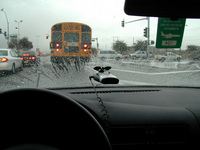Drivers Beware of Wet Weather
As Midpoint of Winter, Groundhog Day Can Serve as Annual Driver Safety Check
HOUSTON, TX January 19, 2009; A report released in June 2008 concluded that nearly a quarter of all automobile accidents occur in rainy and wet weather. According to Rain-X,(1) accidents in wet weather may in part be attributed to the nearly 78 percent of motorists that only change their wiper blades after the blades begin to impair visibility and become a potential safety hazard.(2)
“Ninety percent of driving decisions are based on clear vision,” says Jody DeVere, President and CEO of the #1 women’s auto advice website, AskPatty.com. “Annually changing your wiper blades, as well as performing quick safety checks, can increase safety during inclement weather, especially during the winter months. It is that yearly reminder to change your blades that is vital to maintaining roadway visibility and there is no better reminder than Groundhog Day when people are already thinking of the weather.”
Clear visibility through the use of effective wiper blades and a windshield treatment while driving can improve reaction times by up to a full second in poor weather conditions. When traveling at 60mph, a full second can equate to 100 feet and may be the difference in avoiding a potential accident.(3)
To raise awareness around the issues of clear vision and safe driving, Rain-X is teaming up with Jody DeVere to spread this important safety message and mark Groundhog Day as an annual reminder for motorists to change their wiper blades and prepare their vehicles for unpredictable driving conditions. DeVere suggests several tips to stay safe amid the rain, snow, slush and ice:
Conduct a regular walk around your vehicle, checking its lights, antifreeze, windshield washer fluid and wiper blades regularly.
Ensure that your tires are properly inflated and have sufficient tread.
As the temperature drops, keep your gas tank at least half full; the extra gas helps reduce condensation that can plug your fuel line with ice and stall your engine in cooler weather.
Create an emergency pack of items such as a blanket, a first aid kit, snacks, bottled water, an ice scraper, a flashlight and a bag of kitty litter, and keep it in your vehicle. Such items can be critical during roadside emergencies in heavy rain or snow stormssnowstorms.
“In addition to keeping these emergency items in the vehicle, drivers should adjust their driving habits in inclement weather,” continues DeVere. “Drivers should slow down when the roadways are wet, leave extra distance between your vehicle and the one in front of you, and be sure to use signals when changing lanes to indicate your intentions. Utilizing these quick and easy safety tips can help keep everyone safer on the roads.”



